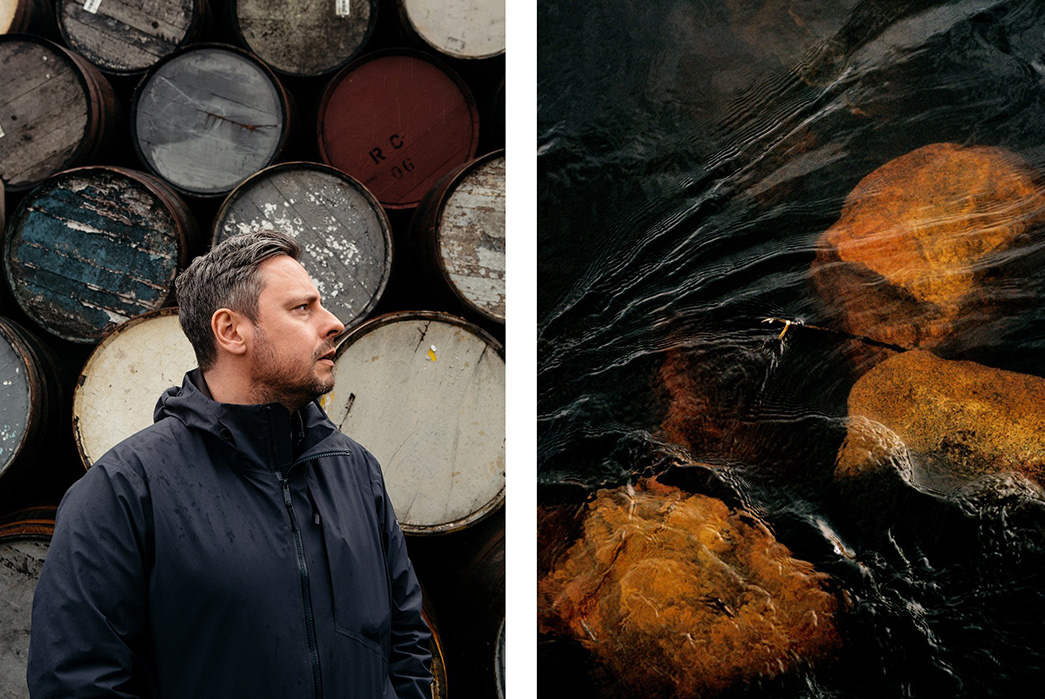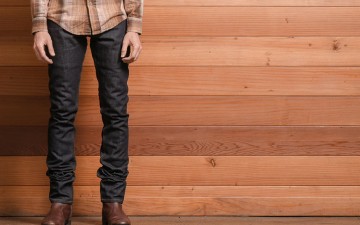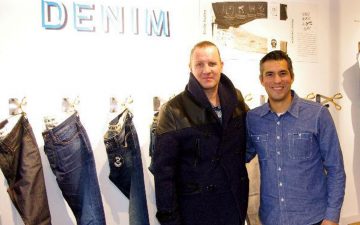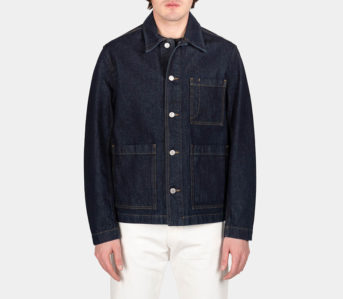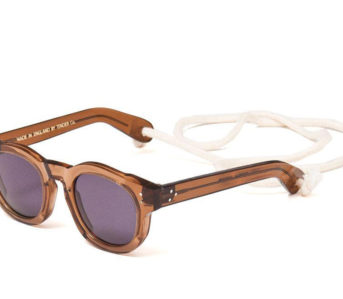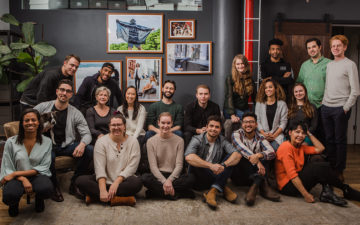The menswear world is built on those who have dedicated their lives to their craft and perfected their skills, often over a prolonged period of time. In addition, you will often find that alongside these lifelong pursuits, those who have stood the test of time in menswear have known little else.
One such many who fits the above profile is Kestin Hare. Now leading his namesake brand Kestin through the menswear maze, Kestin is no stranger to this world. From working in retail at a young age to studying fashion and becoming Head Menswear Designer at heritage heavyweight Nigel Cabourn, Kestin’s humble beginnings and hard work have led him to a place where he is able to enjoy what he loves.
From visiting factories and selecting fabrics to arduously researching each season’s concept and gathering inspiration, Kestin Hare is in his element. Growing up in East Lothian and citing his grandfather Bill Hare (a spitfire pilot and pub landlord) as his earliest style inspiration, Kestin is grounded, humble, and present.
We recently sat down with the man himself to talk about everything from his childhood and transition into fashion, to his time with one of the biggest British menswear designers and how things have a way of coming full circle.
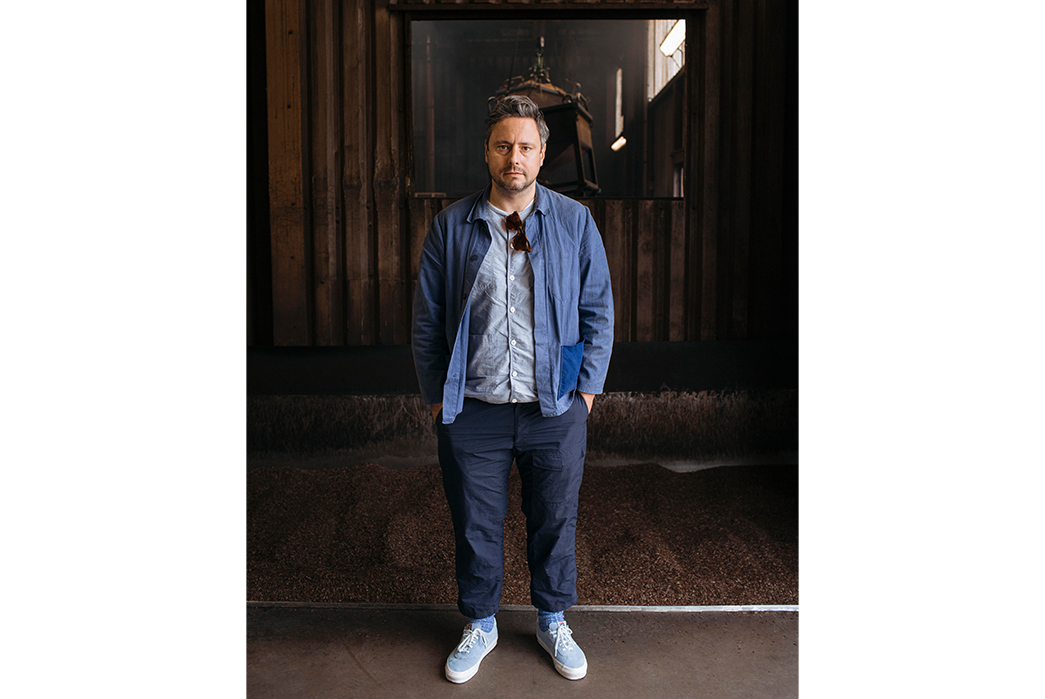
Image via Kestin
Heddels (H): What are some of your earliest memories growing up in East Lothian and around Edinburgh?
Kestin Hare (KH): My grandfather and my dad were both big influences on me—being the only boy and having three sisters, you were always looking for some male support and had to stick together! My dad was an architect by trade and is an incredible drawer to this day, I can always picture him sat at an architect’s table with his fine liners out and drawing.
It was a huge influence on me, we were all encouraged to draw as much as possible and to be creative. My mum was an interior designer, so we had these very creative parents and most holidays usually included getting the water coolers out and having a go at painting landscapes of wherever we were visiting.
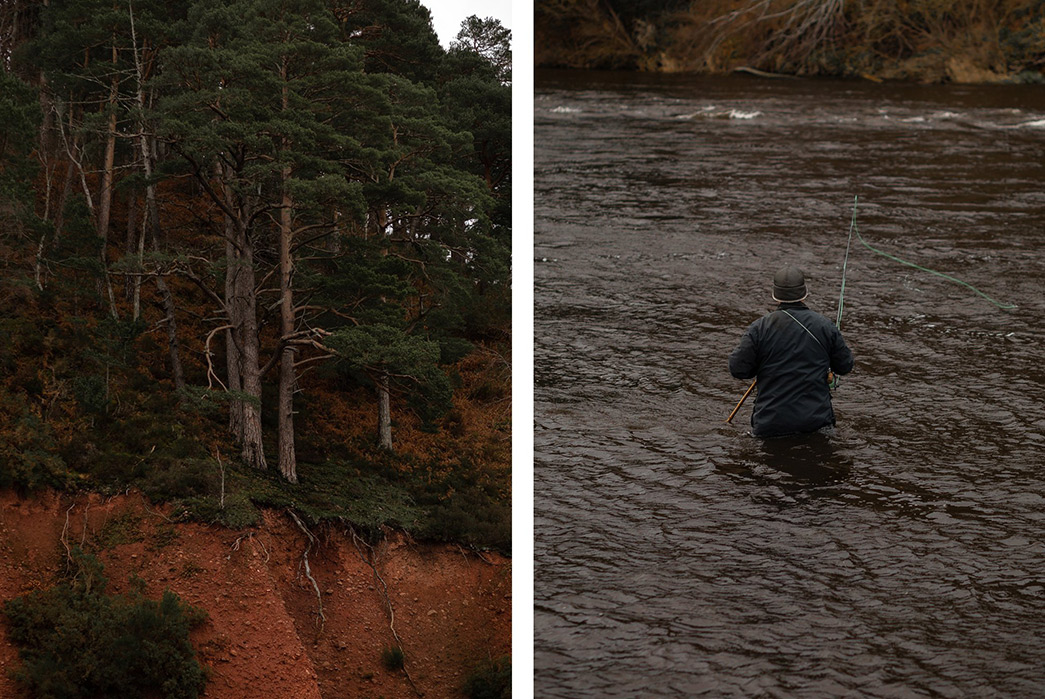
The natural environment and surroundings of Scotland have long been an inspiration for Kestin (image via Kestin)
My Grandfather was an incredibly stylish and cool man—I can remember most Sunday afternoons were spent sitting beside the fire with him telling me stories of when he was a Spitfire pilot during the war and was shot down over Rhodesia. He would bring out his old uniform and I was totally blown away.
Later on, I took a pattern from his old RAF jacket and it was one of the first garments I ever made. I can remember tracing a pattern and memorizing all the details; the construction inside the jacket and the various insignia. He used to drive a [Land Rover] Defender—which made me want to get one—and always had this dashing look. He was a stylish guy, but almost without knowing it.
We still go out to East Lothian on the weekends to get out of town or go to the beach—I drove into Haddington in my Defender recently and stopped to go the local butchers. Pete, who runs the butchers, hadn’t seen me for almost 25 years. As soon as I walked in the door he remarked, “You’re Bill Hare’s grandson—you’re just like him.”
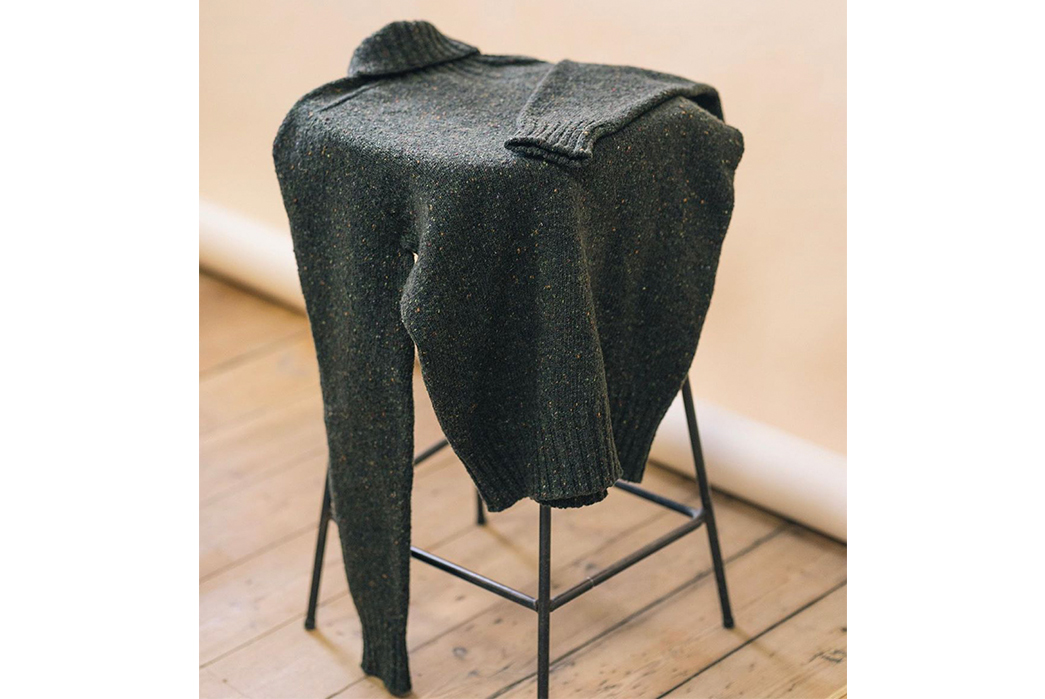
Knitwear has always been key to collections for Kestin (Image via Kestin)
I remember fly fishing with my grandfather and dad when I was younger. I still fish now and find it an amazing, relaxing experience to get away from everyday life and the distractions everything. Growing up in Scotland you either play golf or fish—you get a rod of some kind!
I also got into clubbing—my best mate lived in Glasgow and Edinburgh didn’t have much in the way of clubs, so I’d go up there from the age of twelve. Later studying fashion at the University of Northumbria, Newcastle had a huge club scene which was spawned out of the Global Underground.
There were some great clubs in North East of England at the time and it was great to be a part of that scene (quite distracting from studying). My best mate now owns what is fast-becoming one of the best clubs in Glasgow and it’s amazing to reflect that we’ve gone through all of our lives embracing these opportunities and experiences.
I also worked at one of the best independent menswear stores in the North East as a ‘Saturday Boy’, at Strand in Newcastle. For its time it was an incredible retail experience with brands like Prada Sport, Neil Barrett, Maharishi and Miu Miu. Combined with studying at fashion college during that same period, provided great inspiration.
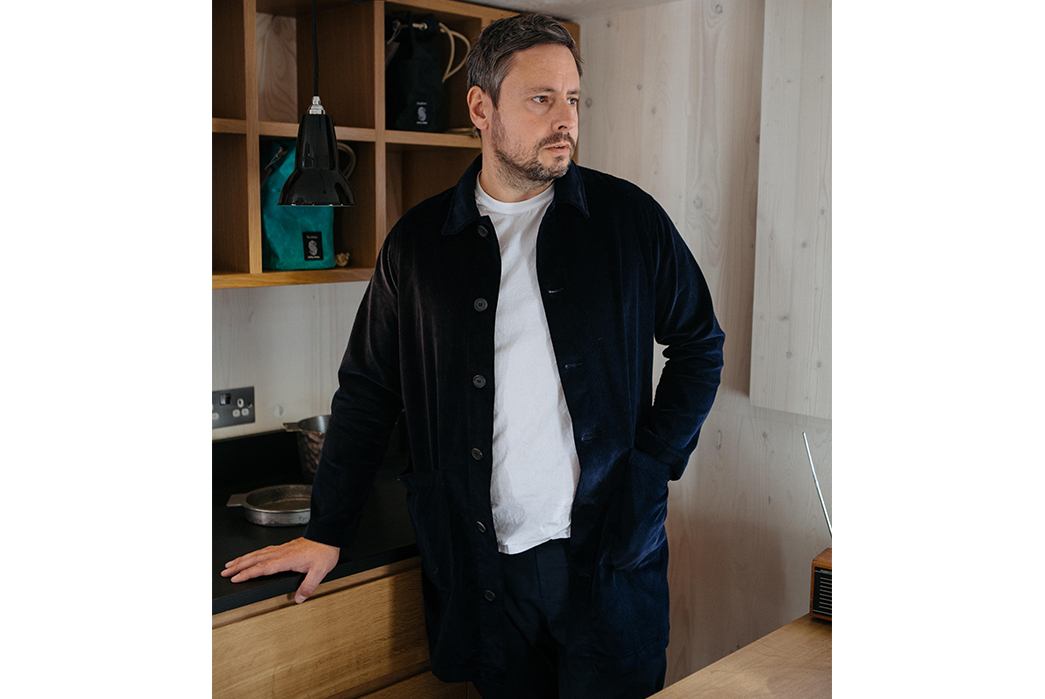
Image via Kestin
H: You obviously knew you wanted to pursue fashion at that point—was there a particular direction you wanted to head in?
KH: I didn’t really know what I wanted to do. At the time the options were really either applying to be an architect or an art teacher and naturally I was encouraged towards architecture (but I didn’t get accepted).
My best mate who was involved in the club scene had a sister who was studying fashion at Northumbria, so we’d go down to visit her in Newcastle and I’d think ‘wow this is cool.’ It made me realize that maybe I could do this too, so I applied and got accepted. But in my first year I was too distracted by going out clubbing!
I think you’re always influenced heavily by the lecturers and people around you, those in a position of influence. I was fortunate enough to have a few lecturers that worked in industry and had started teaching—I was really inspired by them.
The lecturer that taught me pattern cutting, her husband was head of design at vintage inspired brand Nigel Cabourn (which was based in Newcastle). I was introduced to Gary (who is now head of design at Barbour) who brought me in and showed me the ropes. I’d go up to The Windmill in Newcastle where Nigel was based at the time, to help out and cut patterns.
That was what got me inspired by vintage clothing, as it was always around. Even though I’d collected pieces beforehand, it wasn’t until I met Nigel that it really cemented itself in terms of design inspiration. At the time, there were a few big vintage collectors in the world and Nigel was definitely one of them.
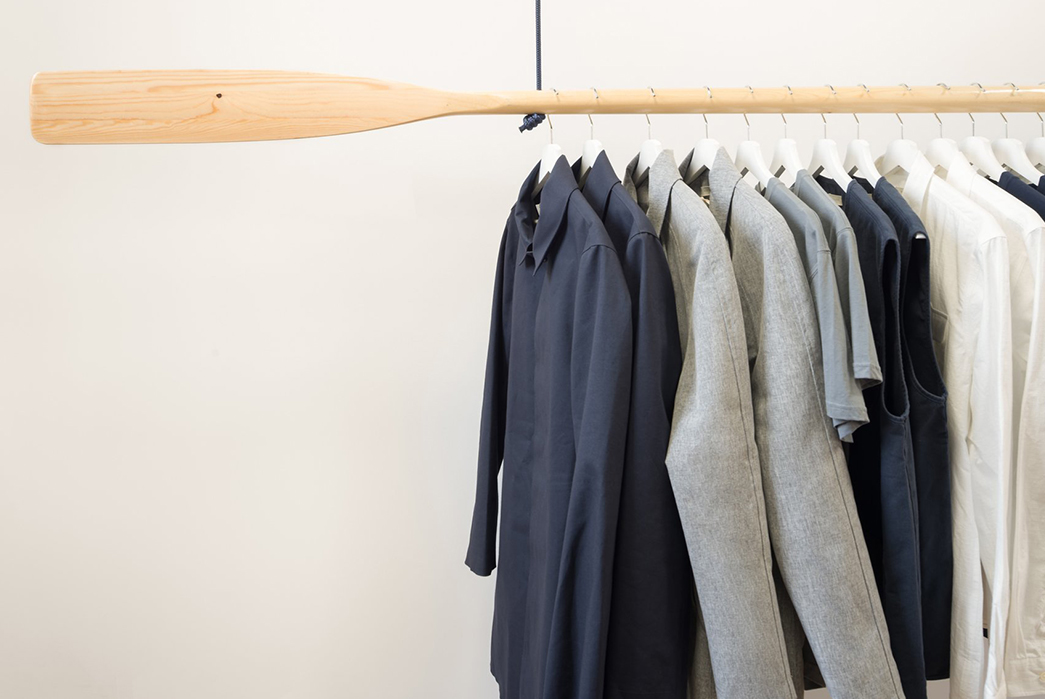
Part of the Kestin flagship store in Leith (Image via Kestin)
When I came back to work for him, the pieces that he was finding and the effort he was going to in order to source them was incredible. These were rare pieces—Ursula submariner jackets, B7 sheepskin jackets—pieces that people hadn’t really seen before. Nigel would go to the ends of the earth to find and then recreate them in the original factories that made them (often using the original fabric and trimmings). That as a training for a young designer was incredible.
Back then we would design using Photoshop—this was before we started to design using illustrator and it became the industry standard we now know. Nigel would have a vintage garment and I would photograph it in the studio and then (quite archaically) take one half of a jacket and stick it on top of another jacket.
And that was the birth of the Cameraman Jacket. This was a huge influence on me as a designer and the way I work today—it’s not rocket science.
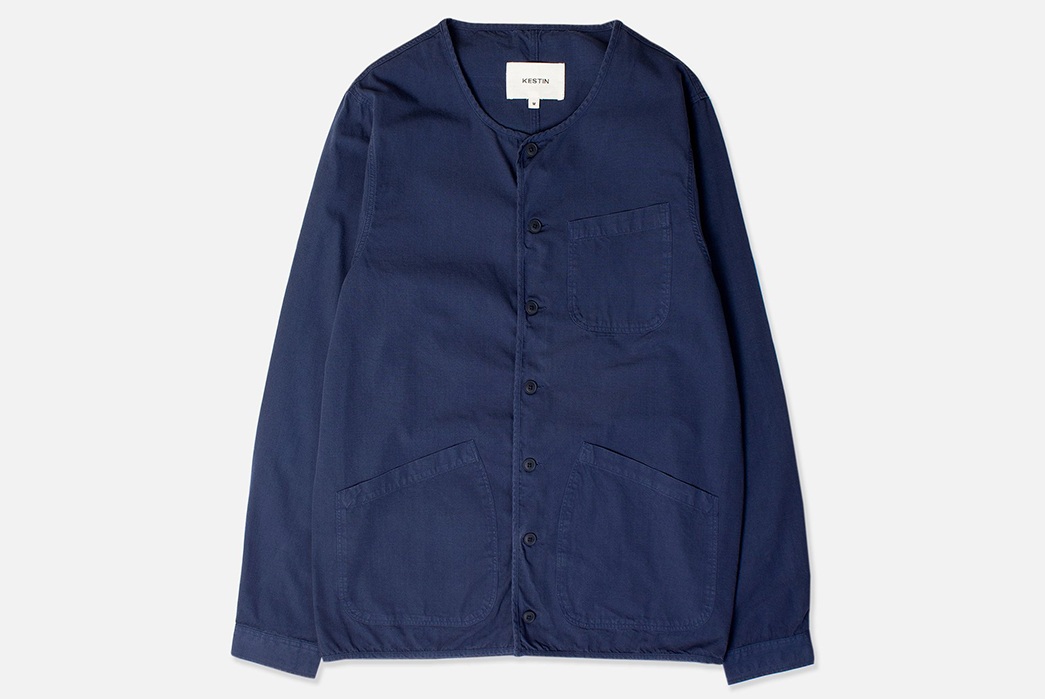
The Neist overshirt has become a Kestin classic over past seasons (Image via Kestin)
My degree at Northumberland was four years which include a one year placement. The Creative Director at Reiss—Lionel Cockley—had set a brief for our students and the winner would get a three month placement with the company. I won and it ended up being a twelve-month placement with the brand, which was a very different brand to what it is now.
David Reiss is an amazing man and the brand was just finding its feet. It was a small team and David had been buying Italian collections to sell in his store on the King’s Road in Chelsea. I think he felt he could do it better and decided to start his own brand under his namesake. It was my first real experience of working in a studio environment and I found myself fascinated by it all.
I thought I’m going to throw myself into this 100% and I was going to absorb every single bit of it. I remember David standing over me and I had to have a really steady hand when drawing (I guess that’s where my dad’s architecture came in). I felt like I’d found my calling. I had a great time at Reiss; they ended up sponsoring my final degree show and offering me a job after graduation.
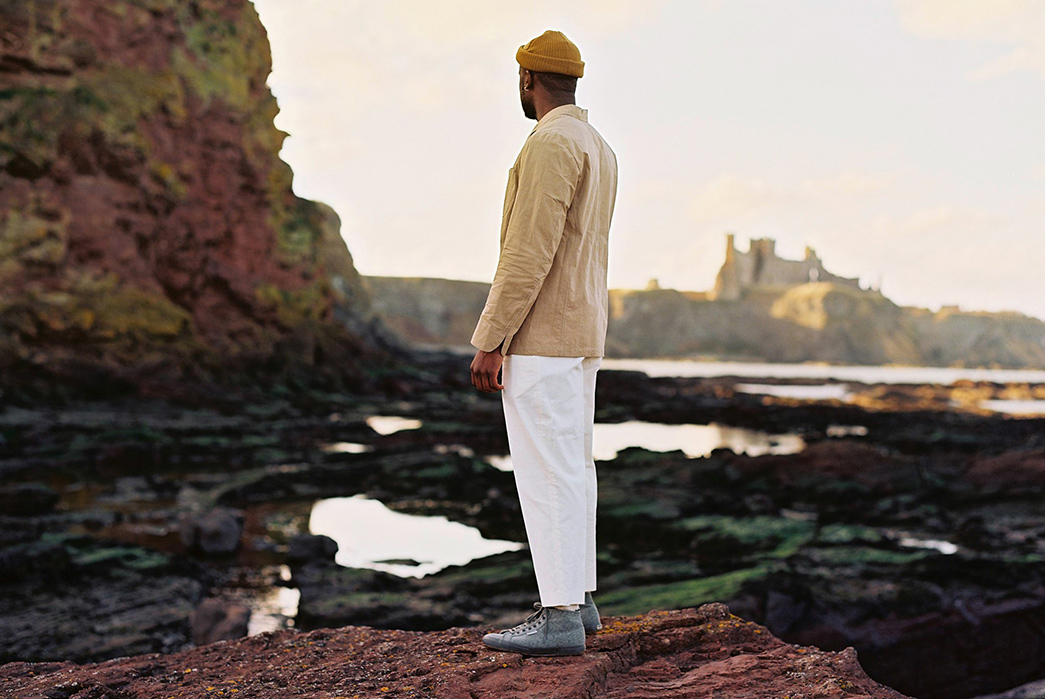
Even since his early days being around Nigel Cabourn, Kestin has always acknowledged the importance of tailoring, fine fabrics and inspiration from vintage pieces (image via Kestin)
I went back to London after graduation, but during my final year I’d spent more time at Nigel’s studio and became quite obsessed by inspiration from the vintage pieces he’d collected. This was on the eve of ‘The Ascent of Cabourn’ collection and it was an amazing time to be there.
While I was down in London, a job came up with Nigel and a woman I was seeing at the time was from the North East. So I moved back to and Gary was moving on, so I got pushed to the front by Nigel and became Head of Design fairly quickly. We had a great relationship with the Japanese at the time and it was like a big family environment.
We designed and produced limited edition collections that were amazing, I’m not sure we realized how good they were at the time!
I then went through a change in my life and things came to an end at Nigel Cabourn after four years, so I moved back to Edinburgh. I started to do freelance work with Burberry and Margaret Howell, but I really wanted to start running things by myself—as I’d be effectively doing that at Nigel Cabourn—using the factories I’d built relationships with.
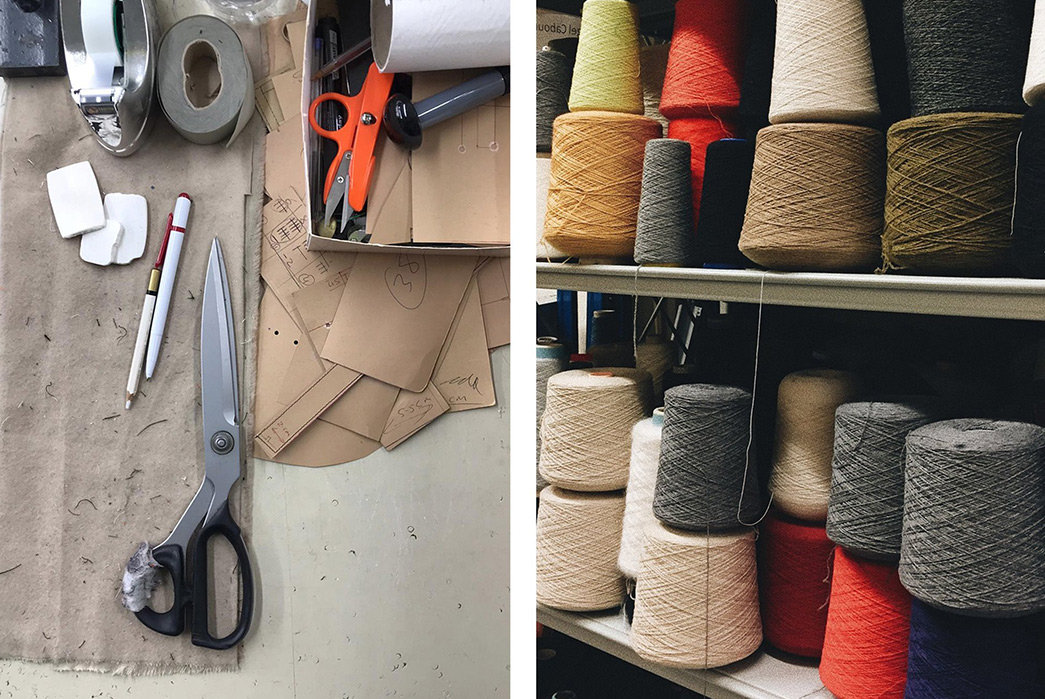
(Image via Kestin)
H: Did you always want your own brand eventually—was that the intention all along?
KH: When I finished studying I wanted to work for a Burberry or a Watanabe—I wanted to work for a brand name. It developed organically over time and from working with such a small team at Nigel Cabourn, I felt I could do it myself. I had good relationships with factories that we’d worked with but I didn’t have enough experience to go it alone (although I thought I did!).
The first time I tried to do things myself it didn’t really work, so I continued to freelance.
It wasn’t until I got introduced to somebody that was trying to set up a menswear brand—he already had a shoe brand at the time, but wanted to do clothing—which became Common People. He was making shoes in Northampton but also wanted to make clothes in the UK. I was introduced as the person who could help realize that.
It began as freelance work and we ended up getting into some great accounts, but we couldn’t finance the production and he couldn’t afford to pay me. So I took some equity in the business and we made some small runs in factories that I’d used before, but finance was still tough.
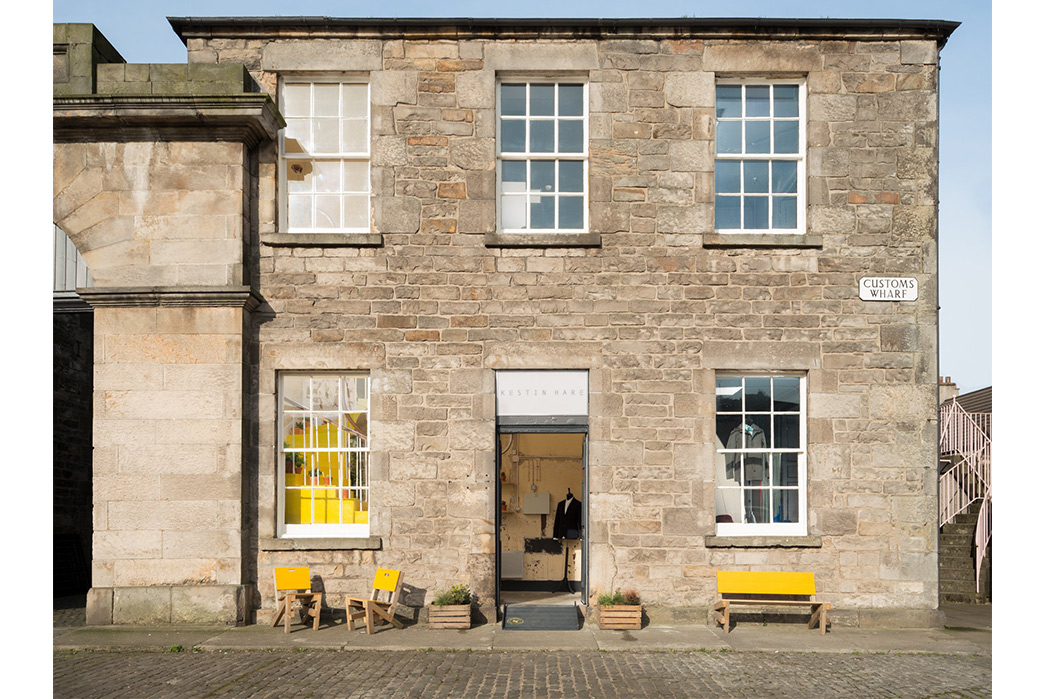
The Cruise Store in Leith which acts as the flagship for the Kestin brand (Image via Kestin)
We launched in Japan very quickly, on the back of my history and reputation there from my time at Nigel Cabourn. The ‘Made in the UK’ thing and history appealed to the Japanese and they were fairly easy to deal with through a trading company. But, the business wasn’t really mine and it was difficult to progress the situation.
We decided to draw a line under it and my Japanese partner at the time suggested moving on and changing the name. He felt that using my name would be beneficial because people respected what I’d done and there was already a following. It’s also more personable—and he was right. It was never my intention to use my own name for my brand, it just evolved that way organically.
I was back in Edinburgh freelancing but in the meantime had met a very lovely Scottish woman who was working in London and I decided to move back down there. Most of the work was down there at the time anyway and I fell in love with London again. I’ve got very fond memories of living in North London which is a beautiful, fantastic, and warm place.
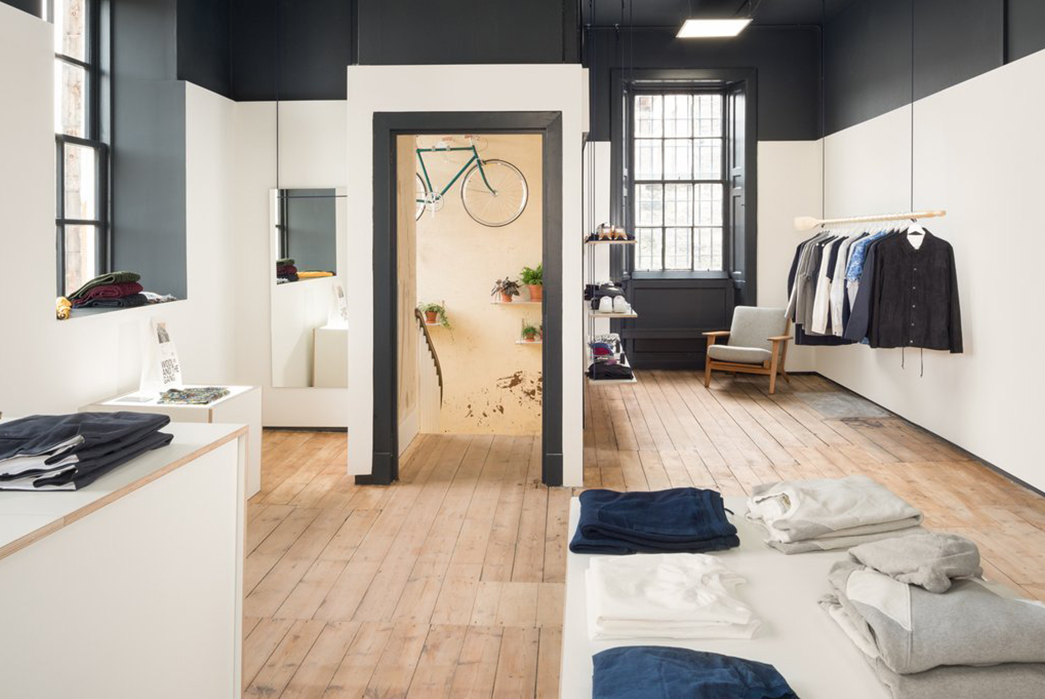
Part of the Kestin flagship store in Leith (Image via Kestin)
I’ve always been a big believer in the arts and being influenced by all types of artistic disciplines. It was important to me that we surrounded ourselves with people involved with these things when we went back to Edinburgh. And you need these disciplines along the way; photographers, designers, and artists etc. I’ve found you get the best results if you immerse yourself right in the thick of that culture. When we came back to Edinburgh, Leith was (and still is) the place to do that.
My friend and I have very much developed a creative ‘hub’ within Leith which is called Custom Lane, it acts as a studio space that backs onto the Cruiser Store which is our flagship in Leith. We have a gallery space with a great art program, guys roasting their own coffee, a yoga studio and the Edinburgh Tool Library (a charity that you can borrow and rent power tools and work tools from) also has its home there.
It’s a very collaborative environment, we’ve really curated the mix of people within the space and we all share the studio together. It’s really important for the brand too, as it’s about much more than just clothes. It’s about everything.
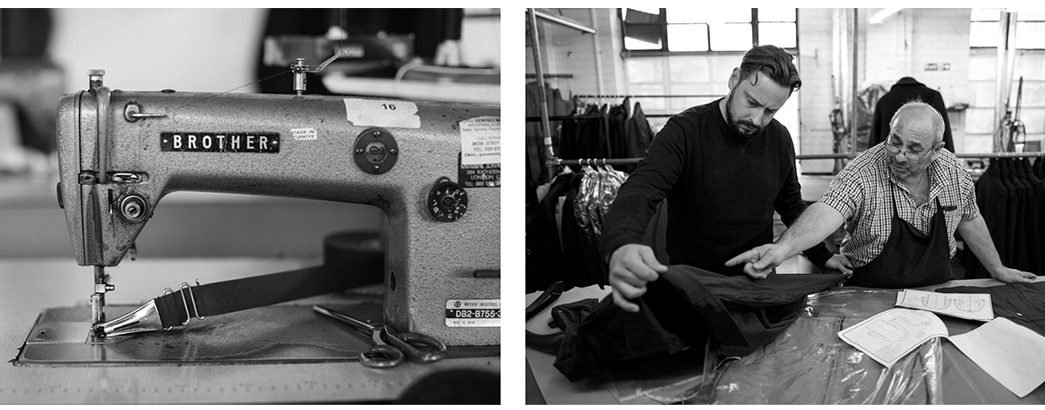
Kestin and his team work meticulously close with their chosen factories to ensure the quality of fabric and garment, producing in the UK whenever possible (Image via Kestin)
H: There have been stories and concepts behind each season for the brand, tell us a little more about creating collections which are ‘more than just product’?
KH: I’ve never been a great fan of calling clothing ‘product’, as it makes it sounds too much like marketing and it’s about much more than the clothes. It’s about a lifestyle. Menswear as we know is about the narrative, and consumers are much more savvy as to how and where things are made. It’s what we believe in too, it’s about an experience.
I’m probably my own worst enemy in terms of pressure on myself to continually make things better and improve what we’re doing. But at the end of the day I’m very lucky—although I’ve worked bloody hard!—and it’s been through people that I’ve met along the way that have inspired me. Which is why I think it’s important to give something back to designers coming through.
We’ve also had fantastic support from the customers over the years, I can’t thank them enough. We’re fortunate to be doing what we love doing, so hopefully that continues.
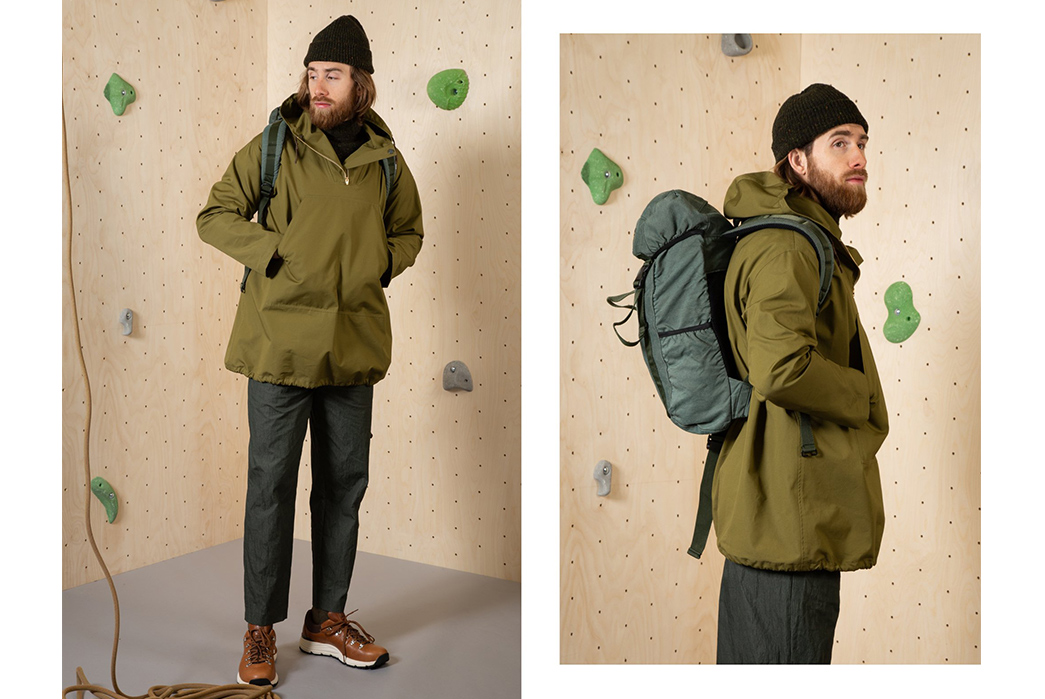
Part of the AW19 collection ‘In High Places’ which included a collaboration with famed outdoor brand Blacks of Greenock (Image via Kestin)
H: What’s next for Kestin—the brand and the person?
KH: We’re working on some exciting projects for the future which I can’t talk about too much but a great collaboration with a British heritage brand which we’ll show during Paris fashion week. It’s a different type of product and it’s been a challenge for our design team, but we’ve really enjoyed working on it.
I’d also like to produce womenswear in the future as well, as we’re getting a lot of women buying our clothes (and looking great in them), so there’s the demand for that already. It would be nice to do a few ladies pieces in future.
We’ll continue to try to push the boundaries of collections and making garments within the UK, which is really important to us. We already cut our own patterns in-house in Leith but it would be great to manufacture some small runs of garments there too. Hopefully we can continue to invest in a bigger, better, and more local design team and studio environment.
